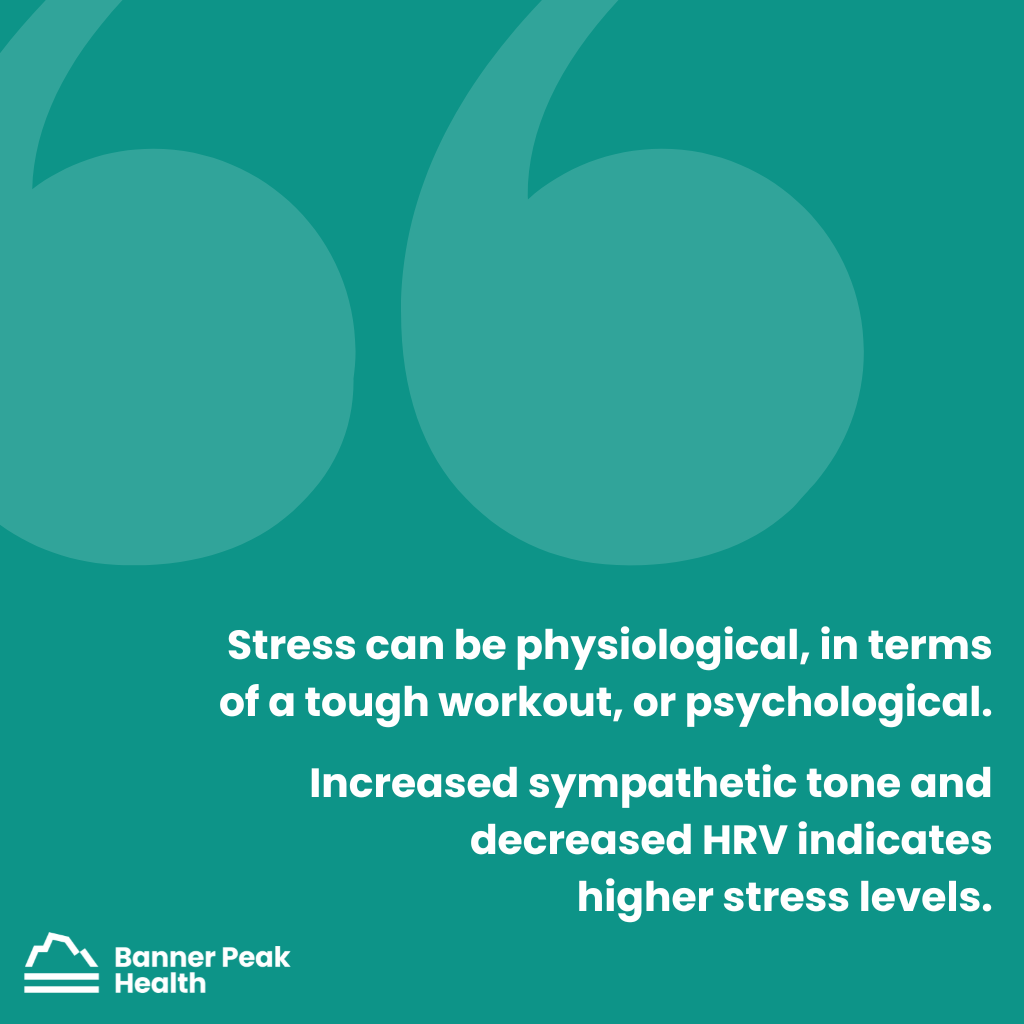Garmin and other wearables that measure heart function quantify stress. But how does Garmin measure stress, exactly?
These devices use heart rate variability (HRV) to quantify stress levels. But is HRV an accurate way to measure stress? The short answer is yes, absolutely.
But now that we can measure our HRV and determine our stress levels with wearables like Garmin, what do we do about it?
That’s what we’ll cover in this post.
Your HRV Is Like a Tesla
I like cars. In 2019, I was fortunate enough to get a Tesla Model 3.
There aren’t many gauges on an electric vehicle’s dashboard, but there is a charge indicator that tells whether you’re consuming electricity (by accelerating onto the freeway or climbing a steep hill, for example) or recharging your battery. As humans, we have a comparable gauge — heart rate variability (HRV).
Let me explain.
Our autonomic nervous system controls all our essential, automatic biological functions. It comprises two almost opposing systems:
- The sympathetic nervous system, which mediates our fight-or-flight response, dilates our pupils for improved vision, enhances our oxygen capacity to run faster, and more. It primes body for action.
- The parasympathetic nervous system, or the “rest and digest” system, which helps with digestion and recovery.
Knowing where we are on the spectrum between the two competing forces of our autonomic nervous system is vital to our health. The key to understanding that balance is heart rate variability.
What Is Heart Rate Variability?
Normally, our heart beats at a regular rate. If you have a heart rate of 60 beats per minute (bpm), you’ll experience 60 beats in one minute, by definition.
However, the spacing between those heartbeats isn’t precisely one second. The competing forces of the sympathetic and parasympathetic nervous systems mediate the timing of every heartbeat we have.
There are variations in the timing between each heartbeat. By measuring this intra-beat difference, we can analyze a concept called heart rate variability.
When there’s more variation in the spacing between heartbeats, the phenomenon reflects signaling from the parasympathetic nervous system. Conversely, less variation in the spacing between heartbeats reflects a predominance of the sympathetic nervous system.
Analogous to the dashboard of the Tesla, by measuring HRV, we get an insight into our body’s current state.
Are we in a predominantly sympathetic situation (accelerating onto the freeway)? Or, are we in a parasympathetic situation (recharging our batteries and recovering)?
Why Measure HRV?
Heart rate variability first became popularized in the athletic community. As discussed in previous blog posts, physical training is a process of:
- Initiating stress in our body
- Recovering from that stress to come back stronger
- Coming to a new equilibrium of greater strength or aerobic capacity
Athletes trying to maximize their athletic performance want to know how much stress they can put their system under. How much recovery will they need? So, the HRV is uniquely suited to tell athletes whether they can tolerate more strain or need to recover.
For example, a weightlifter who just finished a big workout would need to check their HRV the next day. If the HRV went down, that would reflect a sympathetic predominance, meaning the body hadn’t recovered enough and they may need to modify their workout.
Conversely, if the weightlifter’s HRV were rising, it would indicate a parasympathetic predominance, meaning the body was successfully recovering and could tolerate a more intense workout.
The Role of Stress

In previous posts, we’ve explored the deleterious effects of excess stress. We’ve discussed how stress can cause stress belly and many other bad outcomes, including obesity, high blood pressure, diabetes, cancer, stroke, and heart attack.
The same gauge athletes use to determine whether they’re under stress or in stress recovery can also measure how much stress non-athletes are under.
Stress can be physiological, in terms of a tough workout, or psychological. Increased sympathetic tone and decreased HRV indicates higher stress levels.
We know how damaging stress can be, but it’s been challenging to quantify. Fortunately, we now have tools that accurately measure a body’s total burden of stress.
Enter: Garmin and other wearables that measure heart function.
How Does Garmin Measure Stress?
So, how does Garmin measure stress?
For the last 120 years, we’ve measured heart rate using electrical signals.
The first apparatus weighed over 600 lbs and required five people to operate. Today, a wearable heart rate monitor, like Garmin or an Apple Watch, connects to a smartphone app to detect and record data, including heart rate variability.
The newest development in iPhone watches and other wearables is an optic sensor mechanism that shines an LED light into the superficial skin. The sensor monitors the light reflected back to determine the pulse-by-pulse change in the shape of a tiny artery beneath the skin.
This technology has gotten remarkably accurate. As a result, we’re entering an era of readily-measurable HRV. Anyone who wears a Garmin, an Apple Watch, or another wearable that tracks heart function can potentially use it in this way.
As we explained above, HRV is an accurate way to quantify and measure stress.
Researchers have been studying HRV as it applies to various disease states. Just as stress is a risk factor for bad outcomes, so too is diminished heart rate variability. These outcomes include cardiovascular disease, cancer, diabetes, and inflammatory conditions.
How to Improve Your Heart Rate Variability
Wearables like Garmin and the Apple Watch could provide incredible new data for scientists to study and gain insights. By increasing sample sizes from a few participants in a laboratory to potentially hundreds of thousands of 24/7 users, the potential for vast amounts of data is staggering.
While we don’t have all the answers yet, we do know some basic ways you can improve your HRV (and your health in general).
- Get proper rest — ensure you get enough quality sleep.
- Reduce alcohol intake — studies show alcohol consumption diminishes your HRV.
- Maintain consistent eating and sleeping times — stay within your circadian rhythms.
- Meditate and practice deep breathing exercises — these can help with parasympathetic tone.
- Exercise — helps improve sympathetic tone.
What’s Next?
We began this post with the question, “How does Garmin measure stress?” We’ve answered that — Garmin and other wearables that measure heart function measure stress by detecting your heart rate variability (HRV).
We’ve also explained why measuring and monitoring your stress and HRV is important — both can affect your overall health and wellness.
You can take the first steps toward improving your HRV by following the tips listed above. If you want to further explore your heart rate variability and other important health indicators, that’s our specialty at Banner Peak Health.
We create personalized care plans for each of our members and focus on what’s important to you. Contact us today if you’re interested in our services.

Barry Rotman, MD
For over 30 years in medicine, Dr. Rotman has dedicated himself to excellence. With patients’ health as his top priority, he opened his own concierge medical practice in 2007 to practice medicine in a way that lets him truly serve their best interests.




